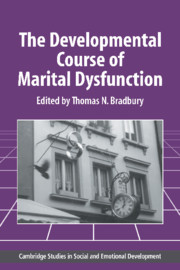Book contents
- Frontmatter
- Contents
- List of Contributors
- Foreword
- Introduction: The Developmental Course of Marital Dysfunction
- Part I Conceptual and Empirical Contributions
- 1 Communication in Early Marriage: Responses to Conflict, Nonverbal Accuracy, and Conversational Patterns
- 2 Marital Aggression, Quality, and Stability in the First Year of Marriage: Findings from the Buffalo Newlywed Study
- 3 Accommodation Processes During the Early Years of Marriage
- 4 The Psychological Infrastructure of Courtship and Marriage: The Role of Personality and Compatibility in Romantic Relationships
- 5 Happiness in Stable Marriages: The Early Years
- 6 Developmental Changes in Marital Satisfaction: A 6-Year Prospective Longitudinal Study of Newlywed Couples
- 7 The Development of Marriage: A 9-Year Perspective
- 8 Premarital Predictors of Relationship Outcomes: A 15-Year Follow-up of the Boston Couples Study
- 9 Optimizing Longitudinal Research for Understanding and Preventing Marital Dysfunction
- 10 Socialization into Marital Roles: Testing a Contextual, Developmental Model of Marital Functioning
- 11 Physical Aggression in Marriage: A Developmental Analysis
- Part II Invited Commentaries
- Author Index
- Subject Index
5 - Happiness in Stable Marriages: The Early Years
Published online by Cambridge University Press: 13 October 2009
- Frontmatter
- Contents
- List of Contributors
- Foreword
- Introduction: The Developmental Course of Marital Dysfunction
- Part I Conceptual and Empirical Contributions
- 1 Communication in Early Marriage: Responses to Conflict, Nonverbal Accuracy, and Conversational Patterns
- 2 Marital Aggression, Quality, and Stability in the First Year of Marriage: Findings from the Buffalo Newlywed Study
- 3 Accommodation Processes During the Early Years of Marriage
- 4 The Psychological Infrastructure of Courtship and Marriage: The Role of Personality and Compatibility in Romantic Relationships
- 5 Happiness in Stable Marriages: The Early Years
- 6 Developmental Changes in Marital Satisfaction: A 6-Year Prospective Longitudinal Study of Newlywed Couples
- 7 The Development of Marriage: A 9-Year Perspective
- 8 Premarital Predictors of Relationship Outcomes: A 15-Year Follow-up of the Boston Couples Study
- 9 Optimizing Longitudinal Research for Understanding and Preventing Marital Dysfunction
- 10 Socialization into Marital Roles: Testing a Contextual, Developmental Model of Marital Functioning
- 11 Physical Aggression in Marriage: A Developmental Analysis
- Part II Invited Commentaries
- Author Index
- Subject Index
Summary
With so many marriages ending in divorce, researchers studying marriage have focused their attention on factors that contribute to marital stability or breakup. Some of these factors have been structural (Kitson, 1992; Teachman & Polonko, 1990), some have been psychological (Gottman & Levenson, 1988), and some interpersonal (Gottman & Krokoff, 1989; Levinger, 1965). Hatchett, Veroff, and Douvan (1996) have dealt with all these levels of analysis simultaneously. But whether such factors are indeed responsible for especially happy marriages is yet another question. Cuber and Harroff (1965) long ago made an important distinction among types of marriages in which husbands and wives may have no question about maintaining loyalties to their spouses and the future of their bonds: Some reflected vital satisfying interdependent relationships while others did not. Among those committed to each other but less satisfied were couples who maintained highly independent life spheres in which husbands and wives had little to do with each other as well as couples whose daily interactive lives were devoid of any vital core of gratifying experience.
What accounts for satisfying marriages among those couples who are unquestionably committed to each other? That is the topic of the current chapter. Having a satisfying marriage is more than just remaining married to someone; it is more than just living by commitments to stay together until “death do us part.”
- Type
- Chapter
- Information
- The Developmental Course of Marital Dysfunction , pp. 152 - 179Publisher: Cambridge University PressPrint publication year: 1998
- 16
- Cited by



